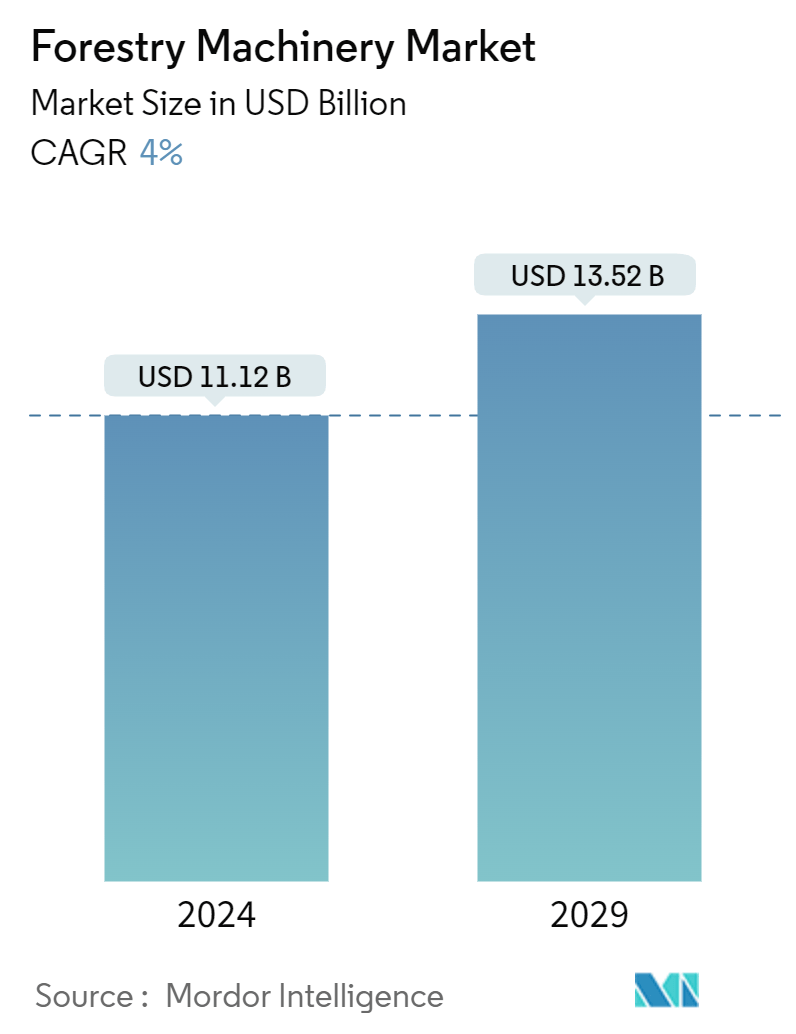Market Size of Forestry Machinery Industry

| Study Period | 2019 - 2029 |
| Market Size (2024) | USD 11.12 Billion |
| Market Size (2029) | USD 13.52 Billion |
| CAGR (2024 - 2029) | 4.00 % |
| Fastest Growing Market | Asia-Pacific |
| Largest Market | Europe |
| Market Concentration | Low |
Major Players
*Disclaimer: Major Players sorted in no particular order |
Forestry Machinery Market Analysis
The Forestry Machinery Market size is estimated at USD 11.12 billion in 2024, and is expected to reach USD 13.52 billion by 2029, growing at a CAGR of 4% during the forecast period (2024-2029).
The forest machinery market is steadily growing, fueled by a rising awareness of sustainable forest management and an increasing demand for wood-based products. These machines, essential for logging, thinning, and harvesting, are pivotal in maximizing productivity while minimizing environmental impact. The surging demand for timber, paper, and wood products worldwide shows huge opportunities for forest machinery manufacturers. Technological innovations, such as enhanced engine efficiency and lower emissions, also bolster market growth. For instance, Ponsse launched the EV1 in September 2022, the first fully electric forwarder. Operating solely on battery power, the EV1 boasts zero emissions, underscoring a significant stride toward sustainability in forestry machinery and aiming to curtail the carbon footprint of logging and forest management.
A major driver for the market’s growth is the incorporation of GPS and telematics systems into forestry equipment. These advancements facilitate real-time tracking, precision harvesting, and heightened operational efficiency, steering forest management toward sustainability. For instance, in April 2021, Tigercat enhanced the features of its robust RemoteLog and LogOn telematics system. Such upgrades empower operators to fine-tune harvesting precision and boost machine efficiency, leading to reduced fuel consumption and a diminished environmental footprint. North America and Europe lead in embracing such cutting-edge equipment, largely due to the surging demand for wood pallets in power plant fuel. Such trends in these regions align with a broader emphasis on renewable energy and sustainable forest management.
Amid the growing market trend, the United States produced around 1,197 billion cubic feet of industrial roundwood in 2021, according to the US Forest Service. Such substantial output underscores the increasing dependence on advanced forest machinery to cater to the surging demand for wood products. As industrial roundwood production increases, the necessity for efficient equipment becomes more critical to streamline large-scale logging operations, curb labor costs, and boost productivity. With the rise in demand for wood-based products, the forestry machinery market is projected to grow further in the coming years, fueled by continuous technological advancements.
Forestry Machinery Industry Segmentation
Forestry machinery is a machine and power-driven equipment that aids in excavating, harvesting, and finishing a wooded area. The forestry machinery market is segmented by machinery into skidders, forwarders, swing machines, bunchers, harvesters, loaders, and other forestry machinery. By geography, it is segmented into North America, Europe, Asia-Pacific, South America, and Middle East and Africa. The report offers market sizing and forecasts in value (USD) for all the above segments.
| Machine Type | |
| Skidders | |
| Forwarders | |
| Bunchers | |
| Swing Machines | |
| Harvesters | |
| Loaders | |
| Other Forestry Machinery |
| Geography | ||||||||||
| ||||||||||
| ||||||||||
| ||||||||||
| ||||||||||
|
Forestry Machinery Market Size Summary
The forestry machinery market is poised for steady growth, driven by increasing awareness of forest preservation and the rising demand for wood-based products. The integration of advanced technologies, such as GPS control systems, is enhancing the efficiency and sustainability of forestry operations, particularly in North America and Europe. This technological advancement is coupled with the growing demand for wood pellets as a renewable energy source, further propelling market expansion. The market is also benefiting from the steady demand for timber products and the rising mechanization rates in both developed and developing countries, which are adopting more intensive logging techniques. Countries with significant forest cover, like Russia, are key players in this market, leveraging their natural resources to support the forestry machinery industry.
Europe stands out as the largest and fastest-growing market for forestry machinery, supported by the European Union's policies and financial incentives aimed at promoting forestry activities. The region's diverse forests provide economic and biodiversity benefits, driving the demand for mechanized harvesting technologies. The shift towards mechanical harvesting is also seen as a response to the increasing global food demand, which has led to the conversion of forest lands into arable lands, thereby necessitating the adoption of mechanized practices. The market is characterized by fragmentation, with major companies like Deere & Company, Komatsu, and Caterpillar competing not only on product quality but also through strategic initiatives to expand their market share. Recent innovations, such as Komatsu's new forestry processor and John Deere's Intelligent Boom Control, highlight the industry's focus on enhancing productivity and efficiency in forestry operations.
Forestry Machinery Market Size - Table of Contents
-
1. MARKET DYNAMICS
-
1.1 Market Overview
-
1.2 Market Drivers
-
1.2.1 Increasing Mechanization in Forestry Machinery
-
1.2.2 Rising Demand for Wood and Wood Products
-
1.2.3 Government Support and Initiatives
-
-
1.3 Market Restraints
-
1.3.1 High Initial and Maintenance Cost of Forestry Machinery
-
1.3.2 Security Concerns in the Forest Machinery Sector
-
-
1.4 Industry Attractiveness - Porter's Five Forces Analysis
-
1.4.1 Bargaining Power of Suppliers
-
1.4.2 Bargaining Power of Buyers/Consumers
-
1.4.3 Threat of Substitute Products
-
1.4.4 Threat of New Entrants
-
1.4.5 Intensity of Competitive Rivalry
-
-
-
2. MARKET SEGMENTATION
-
2.1 Machine Type
-
2.1.1 Skidders
-
2.1.2 Forwarders
-
2.1.3 Bunchers
-
2.1.4 Swing Machines
-
2.1.5 Harvesters
-
2.1.6 Loaders
-
2.1.7 Other Forestry Machinery
-
-
2.2 Geography
-
2.2.1 North America
-
2.2.1.1 United States
-
2.2.1.2 Canada
-
2.2.1.3 Mexico
-
2.2.1.4 Rest of North America
-
-
2.2.2 Europe
-
2.2.2.1 Germany
-
2.2.2.2 United Kingdom
-
2.2.2.3 France
-
2.2.2.4 Russia
-
2.2.2.5 Spain
-
2.2.2.6 Sweden
-
2.2.2.7 Finland
-
2.2.2.8 Rest of Europe
-
-
2.2.3 Asia-Pacific
-
2.2.3.1 China
-
2.2.3.2 Japan
-
2.2.3.3 India
-
2.2.3.4 South Korea
-
2.2.3.5 Rest of Asia-Pacific
-
-
2.2.4 South America
-
2.2.4.1 Brazil
-
2.2.4.2 Argentina
-
2.2.4.3 Rest of South America
-
-
2.2.5 Middle East and Africa
-
2.2.5.1 South Africa
-
2.2.5.2 Rest of Middle East and Africa
-
-
-
Forestry Machinery Market Size FAQs
How big is the Forestry Machinery Market?
The Forestry Machinery Market size is expected to reach USD 11.12 billion in 2024 and grow at a CAGR of 4% to reach USD 13.52 billion by 2029.
What is the current Forestry Machinery Market size?
In 2024, the Forestry Machinery Market size is expected to reach USD 11.12 billion.

